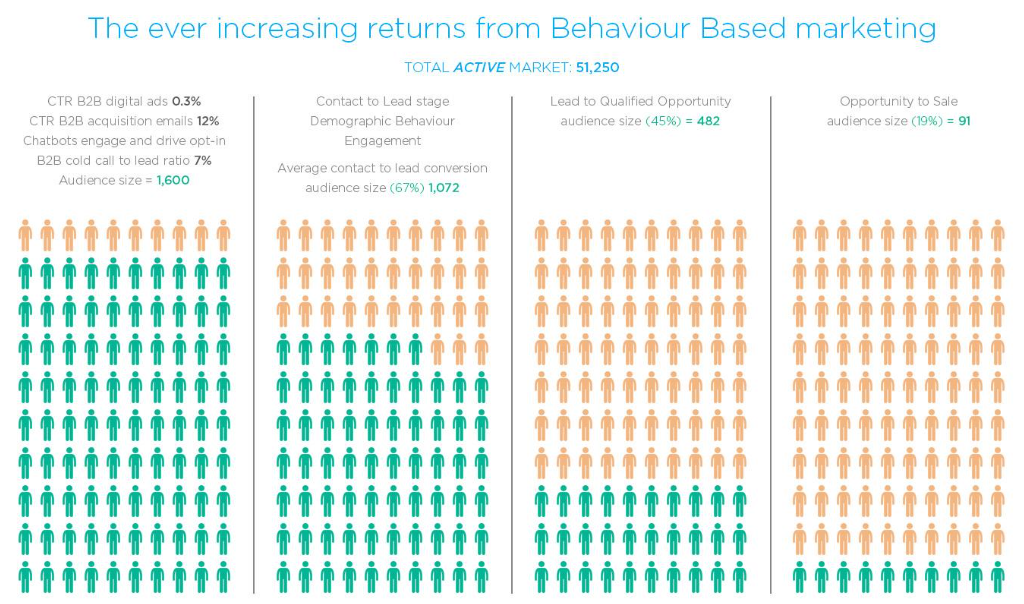How can behavioural intent data and predictive analytics transform marketing and sales strategies? This post from Cyance CEO Jon Clarke explores.
Traditional Mass B2B Marketing Needs To Change
To succeed in an ever-changing, complex marketing landscape, businesses today need to uncover and consider data from digital footprints left by target accounts and contact engagement, and use this business intelligence to refine their approach to marketing and sales.
More specifically, as technology has evolved, it is now possible to leverage intent-data to create buyer behaviour focussed strategies across sales and marketing. In this post from Cyance, we explore what Behaviour Based Marketing (BBM) is, why it’s so effective, and detail how to avoid common organisational barriers to adoption.
Traditional B2B marketing isn’t working as well as it used to. Well, not the spray-and-pray, hit-and-hope variety. While these methods may be reaching larger audiences, in many cases those audiences aren’t relevant, aren’t interested, and certainly aren’t showing any intent to buy. In fact, at any given time, only 2-5% of any given audience is actively seeking to make a purchase.
Changing buying behaviours, technologies, customer choices, competitors and new and ever-tightening regulations, mean that marketers in 2018 are facing a collective challenge like never before, seeing fewer and fewer returns from their volume-based, mass-marketing, despite more effort and spend. Mass-marketing is speculative, inefficient and indiscriminate.

What is Behaviour Based Marketing (BBM)?
We all know that there are means within our reach to change our marketing practices, results and reputations for good.
But what many may not know, is that Behaviour Based Marketing (BBM) - using the very latest predictive analytics, AI and machine learning techniques - will increase typical digital ad CTR by 6x (from 0.06% to 0.38%), boost average MQL to sales pipeline conversion by x3.5 (from 10% to 35%), and cut time and wastage by a huge 66%.

The reason BBM is so effective, is its ability to accurately spot and take action on those elusive intent-to-buy signals exhibited by the tiny and equally elusive 2-5% of your audience who are actively seeking to make a purchase here and now. BBM helps you target this active audience with pinpoint accuracy, create hyper-relevant messaging, and in almost real time.
How Does Behavioural Intent Data Tie Into Inbound and Account-Based Marketing?
For modern B2B marketers, having the ability to uncover almost real-time buying insights on target accounts and markets provides a huge competitive advantage.
If your business has an existing marketing technology stack that connects data from your website, content, event and related touchpoints, you can likely already identify where accounts and existing contacts are within a buyer journey. So you are already ahead of the game!
However, with behavioural insights and intent data, sales and marketing teams can build out a view on accounts that are in-market for their products and solutions before they are engaged with your content, website and teams.
This helps to generate the improved sales and marketing campaign targeting and ROI that is shown in the above graphic. For example, for sales and marketing teams that have worked to develop an Account-Based Marketing playbook and framework, we can engage an account that is starting showing positive buyer intent signals by having the right content, messaging, sales & marketing alignment, and channel tactics in place, which helps to position you ahead of the competition and reduce customer acquisition costs.
This impacts overall ROI, from an inbound and demand gen perspective, through to your ABM programme development considerations.
Addressing Organisational Barriers to BBM
In our experience, there are 5 main barriers to BBM adoption amongst today’s marketers, so we’ve compiled a list to help you recognise them, and take steps towards overcoming them.
1. Fear of the unknown
For many, change implies risk, and with risk comes fear! Fear of unknown, uncharted territory can prevent many organisations from making essential changes, or at the very least, it can slow down decision making.
2. Risk-averse leaders
A move away from volume-based mass-marketing to behaviour-driven, qualitative marketing, means better qualified, but fewer leads. You’ll need to manage the expectations of a leadership team who still expect the same volume and pipeline as before.
3. Drowning by data
More data has been created in the past two years than in the entire previous history of the human race - and by the year 2020, about 1.7 megabytes of new information will be created every second for every human being on the planet. Marketers are increasingly challenged to identify the data that’s relevant, make sense of it and turn it into meaningful actions.
4. Ever more complex buyer journeys
Most buying journeys at least start online and can switch across many different channels over time. A typical B2B buying journey includes an average 9 marketing interactions and 6 calls or conversations. But outside those, prospects both known and unknown, could be researching your brand or service without you ever being aware. All of this makes it difficult to target, personalise and attribute what works and what doesn’t.
The DemandGen 2018 B2B buyers research report claims that the majority of online research, which forms part of a buying journey takes place within the first 3 months. This suggests it is vital that your business can not only spot relevant buying journeys, but also find the customers within the early buying research stages. Otherwise you run the risk of not being part of their journey, or end up purely being benchmarked on price.
5. Ever more complex technology
You know what you need to do, but your technology and operations aren’t up to the job. Add to that the sheer number and variety of new technologies designed to help you, and it can feel like you’re in a minefield of bewilderment. How do you build the right tech stack, manage it, scale it? How do you knit it all together and still extract the data you need?
A minefield indeed. And as if those barriers weren’t enough, there’s more for you to deal with: a new breed of digital-born competitors who seem to be able to do everything faster, better and cheaper; and an ever-widening divide between sales and marketing in a world where collaboration is key.
Right Time, Right People, Right Message
Where volume-based mass marketing is speculative, inefficient and indiscriminate, inbound to ABM, along with behavioural based insight is all about using predictive analytics to target the right people, at the right time, with the right message.
You can make sense of all your available data, and accurately identify the prospects who are potentially ready to buy. You can even target with laser precision and in almost real-time, with messaging that you know will engage and convert, and you can nurture, track and measure every step of the journey.
Images courtesy of Cyance. Parts of this post were originally published here.





